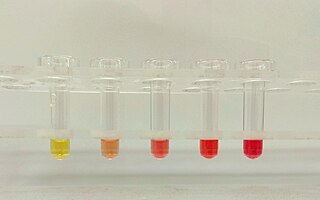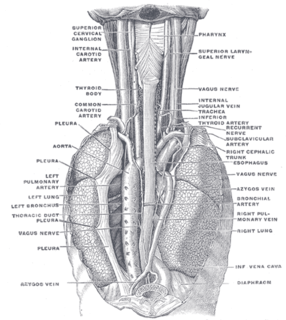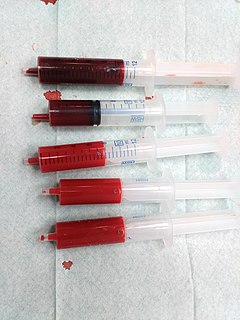Related Research Articles

The lungs are the primary organs of the respiratory system in humans and most animals including a few fish, and some snails. In mammals and most other vertebrates, two lungs are located near the backbone on either side of the heart. Their function in the respiratory system is to extract oxygen from the air and transfer it into the bloodstream, and to release carbon dioxide from the bloodstream into the atmosphere, in a process of gas exchange. Respiration is driven by different muscular systems in different species. Mammals, reptiles and birds use their different muscles to support and foster breathing. In earlier tetrapods, air was driven into the lungs by the pharyngeal muscles via buccal pumping, a mechanism still seen in amphibians. In humans, the main muscle of respiration that drives breathing is the diaphragm. The lungs also provide airflow that makes vocal sounds including human speech possible.

Hemolysis or haemolysis, also known by several other names, is the rupturing (lysis) of red blood cells (erythrocytes) and the release of their contents (cytoplasm) into surrounding fluid. Hemolysis may occur in vivo or in vitro.

Cardiopulmonary bypass (CPB) is a technique in which a machine temporarily takes over the function of the heart and lungs during surgery, maintaining the circulation of blood and the oxygen content of the patient's body. The CPB pump itself is often referred to as a heart–lung machine or "the pump". Cardiopulmonary bypass pumps are operated by perfusionists. CPB is a form of extracorporeal circulation. Extracorporeal membrane oxygenation is generally used for longer-term treatment.

Interventional radiology (IR) is a medical subspecialty that performs various minimally-invasive procedures using medical imaging guidance, such as x-ray fluoroscopy, computed tomography, magnetic resonance imaging, or ultrasound. IR performs both diagnostic and therapeutic procedures through very small incisions or body orifices. Diagnostic IR procedures are those intended to help make a diagnosis or guide further medical treatment, and include image-guided biopsy of a tumor or injection of an imaging contrast agent into a hollow structure, such as a blood vessel or a duct. By contrast, therapeutic IR procedures provide direct treatment—they include catheter-based medicine delivery, medical device placement, and angioplasty of narrowed structures.

Fine-needle aspiration (FNA) is a diagnostic procedure used to investigate lumps or masses. In this technique, a thin, hollow needle is inserted into the mass for sampling of cells that, after being stained, are examined under a microscope (biopsy). The sampling and biopsy considered together are called fine-needle aspiration biopsy (FNAB) or fine-needle aspiration cytology (FNAC). Fine-needle aspiration biopsies are very safe minor surgical procedures. Often, a major surgical biopsy can be avoided by performing a needle aspiration biopsy instead, eliminating the need for hospitalization. In 1981, the first fine-needle aspiration biopsy in the United States was done at Maimonides Medical Center. Today, this procedure is widely used in the diagnosis of cancer and inflammatory conditions.

In human anatomy, the bronchial arteries supply the lungs with nutrition and oxygenated blood. Although there is much variation, there are usually two bronchial arteries that run to the left lung, and one to the right lung and are a vital part of the respiratory system.

Hypoxemia is an abnormally low level of oxygen in the blood. More specifically, it is oxygen deficiency in arterial blood. Hypoxemia has many causes, and often causes hypoxia as the blood is not supplying enough oxygen to the tissues of the body.

Respiratory diseases, or lung diseases, are pathological conditions affecting the organs and tissues that make gas exchange difficult in air-breathing animals. They include conditions of the respiratory tract including the trachea, bronchi, bronchioles, alveoli, pleurae, pleural cavity, the nerves and muscles of respiration. Respiratory diseases range from mild and self-limiting, such as the common cold, influenza, and pharyngitis to life-threatening diseases such as bacterial pneumonia, pulmonary embolism, tuberculosis, acute asthma, lung cancer, and severe acute respiratory syndromes, such as COVID-19. Respiratory diseases can be classified in many different ways, including by the organ or tissue involved, by the type and pattern of associated signs and symptoms, or by the cause of the disease.

Renovascular hypertension is a condition in which high blood pressure is caused by the kidneys' hormonal response to narrowing of the arteries supplying the kidneys. When functioning properly this hormonal axis regulates blood pressure. Due to low local blood flow, the kidneys mistakenly increase blood pressure of the entire circulatory system. It is a form of secondary hypertension - a form of hypertension whose cause is identifiable.
Machine perfusion (MP) is a technique used in organ transplantation as a means of preserving the organs which are to be transplanted.

Plasmodium berghei is a species in the genus Plasmodium subgenus Vinckeia.

Paracoccidioidomycosis (PCM), also known as South American blastomycosis, is a fungal infection that can occur as a mouth and skin type, lymphangitic type, multi-organ involvement type, or mixed type. If there are mouth ulcers or skin lesions, the disease is likely to be widespread. There may be no symptoms, or it may present with fever, sepsis, weight loss, large glands, or a large liver and spleen.
Organ procurement is a surgical procedure that removes organs or tissues for reuse, typically for organ transplantation.

Chronic multifocal Langerhans cell histiocytosis, previously known as Hand–Schüller–Christian disease, is a type of Langerhans cell histiocytosis (LCH), which can affect multiple organs. The condition is traditionally associated with a combination of three features; bulging eyes, breakdown of bone, and diabetes insipidus, although around 75% of cases do not have all three features. Other features may include a fever and weight loss, and depending on the organs involved there maybe rashes, asymmetry of the face, ear infections, signs in the mouth and the appearance of advanced gum disease. Features relating to lung and liver disease may occur.

Ischemic hepatitis, also known as shock liver, is a condition defined as an acute liver injury caused by insufficient blood flow to the liver. The decreased blood flow (perfusion) to the liver is usually due to shock or low blood pressure. However, local causes involving the hepatic artery that supplies oxygen to the liver, such as a blood clot in the hepatic artery, can also cause ischemic hepatitis.
Perfusion is the passage of fluid through the lymphatic system or blood vessels to an organ or a tissue. The practice of perfusion scanning is the process by which this perfusion can be observed, recorded and quantified. The term perfusion scanning encompasses a wide range of medical imaging modalities.

The liver is a major organ only found in vertebrates which performs many essential biological functions such as detoxification of the organism, and the synthesis of proteins and biochemicals necessary for digestion and growth. In humans, it is located in the right upper quadrant of the abdomen, below the diaphragm. Its other roles in metabolism include the regulation of glycogen storage, decomposition of red blood cells, and the production of hormones.

A viability assay is an assay that is created to determine the ability of organs, cells or tissues to maintain or recover a state of survival. Viability can be distinguished from the all-or-nothing states of life and death by the use of a quantifiable index that ranges between the integers of 0 and 1 or, if more easily understood, the range of 0% and 100%. Viability can be observed through the physical properties of cells, tissues, and organs. Some of these include mechanical activity, motility, such as with spermatozoa and granulocytes, the contraction of muscle tissue or cells, mitotic activity in cellular functions, and more. Viability assays provide a more precise basis for measurement of an organism's level of vitality.

Decellularization is the process used in biomedical engineering to isolate the extracellular matrix (ECM) of a tissue from its inhabiting cells, leaving an ECM scaffold of the original tissue, which can be used in artificial organ and tissue regeneration. Organ and tissue transplantation treat a variety of medical problems, ranging from end organ failure to cosmetic surgery. One of the greatest limitations to organ transplantation derives from organ rejection caused by antibodies of the transplant recipient reacting to donor antigens on cell surfaces within the donor organ. Because of unfavorable immune responses, transplant patients suffer a lifetime taking immunosuppressing medication. Stephen F. Badylak pioneered the process of decellularization at the McGowan Institute for Regenerative Medicine at the University of Pittsburgh. This process creates a natural biomaterial to act as a scaffold for cell growth, differentiation and tissue development. By recellularizing an ECM scaffold with a patient’s own cells, the adverse immune response is eliminated. Nowadays, commercially available ECM scaffolds are available for a wide variety of tissue engineering. Using peracetic acid to decellularize ECM scaffolds have been found to be false and only disinfects the tissue.

Fikri Alican was a Turkish scientist and physician with various contributions to medical science, ranging from organ transplantation to physiology.
References
- ↑ Cypel, Marcelo; Keshavjee, Shaf (2016). "Novel Technologies for Isolated Lung Perfusion". Thoracic Surgery Clinics. Elsevier BV. 26 (2): 139–145. doi:10.1016/j.thorsurg.2015.12.002. ISSN 1547-4127. PMID 27112253.
- ↑ Eiseman, B.; Knipe, Peter; McCOLL, H. A.; Orloff, M. J. (1961-09-01). "Isolated Liver Perfusion for Reducing Blood Ammonia". Archives of Surgery. 83 (3): 356–363. doi:10.1001/archsurg.1961.01300150030004. ISSN 0004-0010. PMID 13726167 . Retrieved 2019-06-30.
- ↑ "Isolated Organ Perfusion Studies - Physiology". Harvard Apparatus. Archived from the original on 2019-05-13. Retrieved 2019-06-30.
- ↑ Abbott, William M.; Weinerth, John L. (1971). "The perfusion of isolated whole organs". Cryobiology. Elsevier BV. 8 (2): 113–133. doi:10.1016/0011-2240(71)90019-8. ISSN 0011-2240. PMID 5578880.
- ↑ Guyette, Jacques P; Gilpin, Sarah E; Charest, Jonathan M; Tapias, Luis F; Ren, Xi; Ott, Harald C (2014-05-29). "Perfusion decellularization of whole organs". Nature Protocols. Springer Science and Business Media LLC. 9 (6): 1451–1468. doi:10.1038/nprot.2014.097. ISSN 1754-2189. PMID 24874812. S2CID 7397409.
- ↑ Schjørring, Olav L.; Carlsson, Rune; Simonsen, Ulf (2015). "Pressure Myography to Study the Function and Structure of Isolated Small Arteries". Methods in Mouse Atherosclerosis. Methods in Molecular Biology. Vol. 1339. New York, NY: Springer New York. pp. 277–295. doi:10.1007/978-1-4939-2929-0_19. ISBN 978-1-4939-2928-3. ISSN 1064-3745. PMID 26445796.
- ↑ Serrat, Maria A (2009-11-05). "Measuring bone blood supply in mice using fluorescent microspheres". Nature Protocols. Springer Science and Business Media LLC. 4 (12): 1749–1758. doi:10.1038/nprot.2009.190. ISSN 1754-2189. PMID 19893510. S2CID 29637802.
- ↑ "Tissue bath" (PDF). Archived (PDF) from the original on 2017-06-18. Retrieved 2019-06-30.
- ↑ Yeh, T.; Wechsler, A. S. (1998). "The Isolated Organ in Research". Surgical Research. New York, NY: Springer New York. pp. 435–452. doi:10.1007/978-1-4612-1888-3_49. ISBN 978-1-4612-7325-7.
Technological advances in artificial perfusion allow effective isolated perfusion of a wide variety of organs and tissues, including, but not limited to, brain, heart, lung, heart-lung, liver, kidney, spleen, pancreas, thymus, gastrointestinal tract, urinary tract, reproductive tract, skeletal muscle, nerves, and blood vessels.